

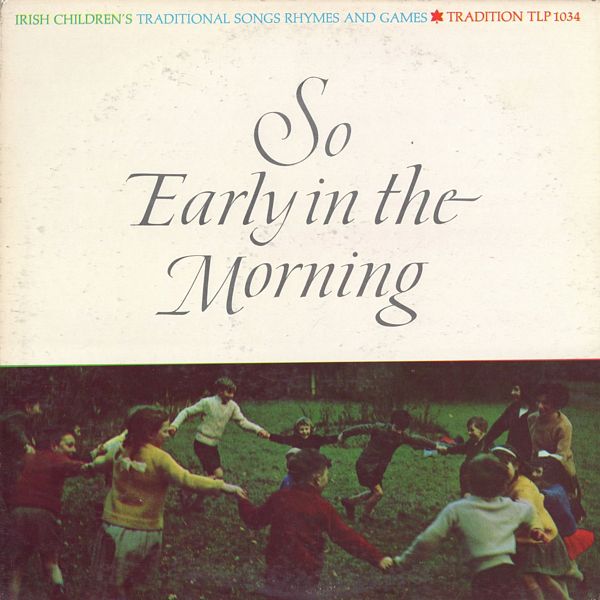 |
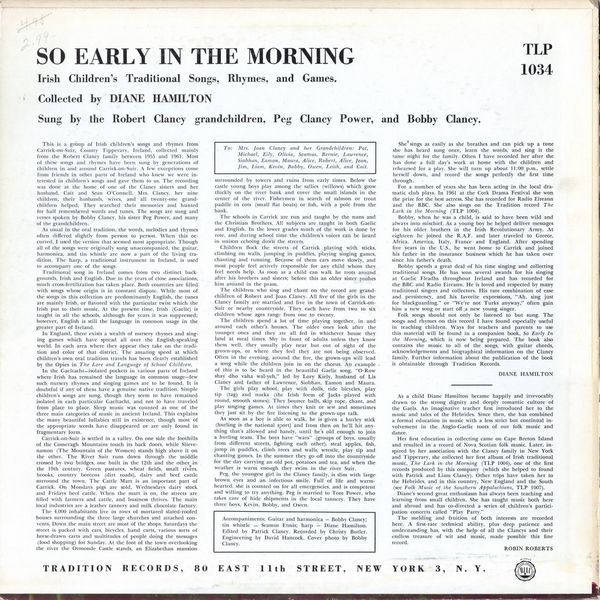
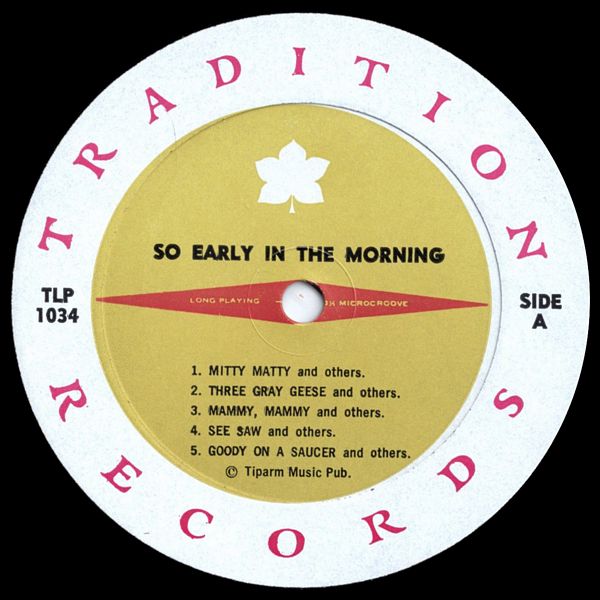
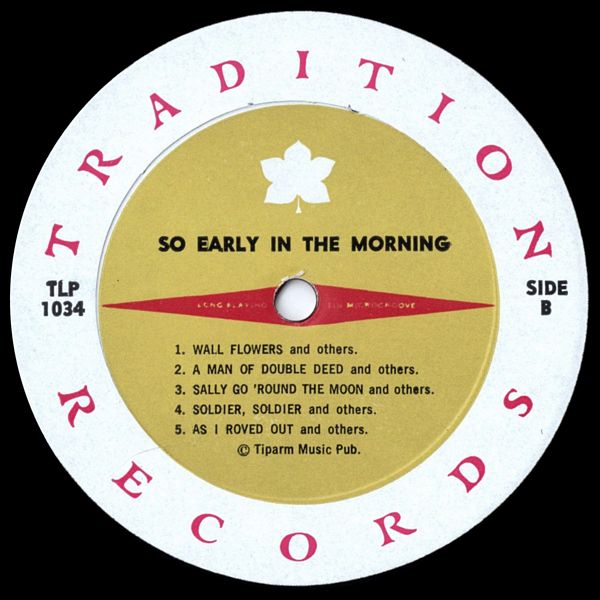 |
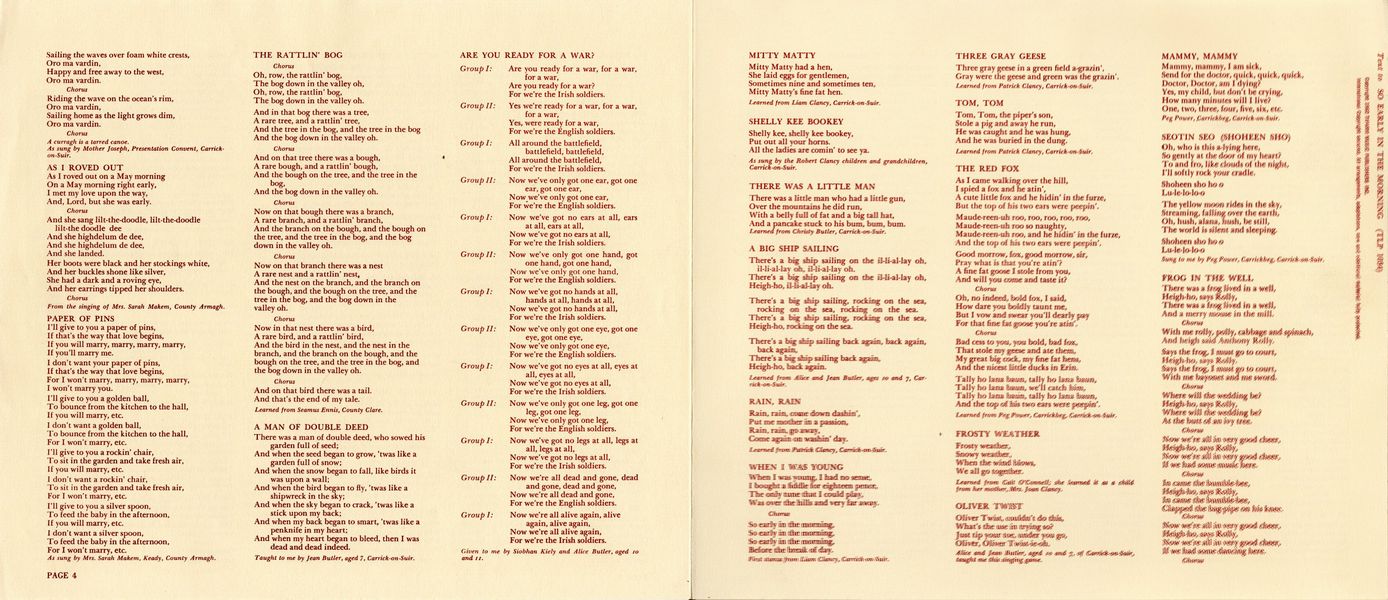
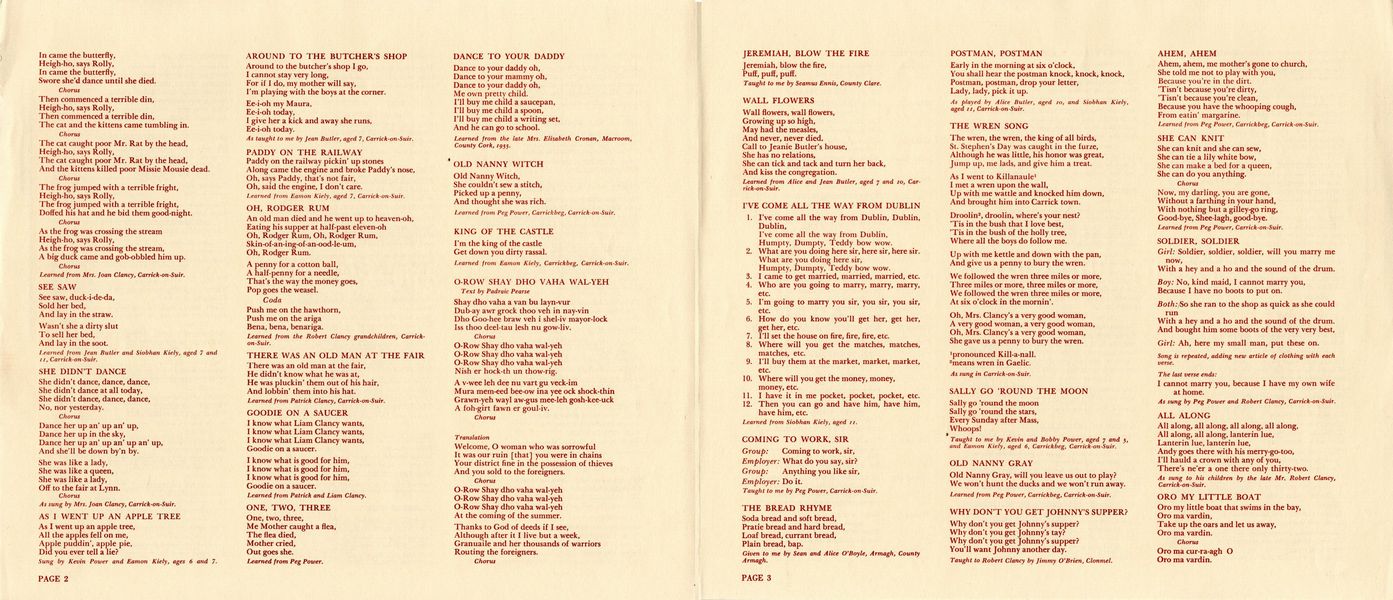
|
Sleeve Notes
To: Mrs. Joan Clancy and her Grandchildren: Pat, Michael, Eily, Olivia, Seamus, Bernie, Lawrence, Siobhan, Eamon, Maura, Alice, Robert, Alice, Jean, Jim, Liam, Kevin, Bobby, Owen, Leish, and Cait.
This is a group of Irish children's songs and rhymes from Carrick-on-Suir, County Tipperary, Ireland, collected mainly from the Robert Clancy family between 1955 and 1961. Most of these songs and rhymes have been sung by generations of children in and around Carrick-on-Suir. A few exceptions come from friends in other parts of Ireland who knew we were interested in children's songs and gave them to us. The recording was done at the home of one of the Clancy sisters and her husband, Cait and Seán O'Connell. Mrs. Clancy, her nine children, their husbands, wives, and all twenty-one grandchildren helped. They searched their memories and hunted for half remembered words and tunes. The songs are sung and verses spoken by Bobby Clancy, his sister Peg (Clancy) Power, and many of the grandchildren.
As usual in the oral tradition, the words, melodies and rhymes often differed slightly from person to person. When this occurred, I used the version that seemed most appropriate. Though all of the songs were originally sung unaccompanied, the guitar, harmonica, and tin whistle are now a part of the living tradition. The harp, a traditional instrument in Ireland, is used to accompany one of the songs.
Traditional song in Ireland comes from two distinct backgrounds, Irish and English. Due to the years of close associations, much cross-fertilization has taken place. Both countries are filled with songs whose origin is in constant dispute. While most of the songs in this collection are predominantly English, the tunes are mainly Irish, or flavored with the particular twist which the Irish put to their music. At the present time, Irish (Gaelic) is taught in all the schools, although for years it was suppressed; however, English is still the language in common usage in the greater part of Ireland.
In England, there exists a wealth of nursery rhymes and singing games which have spread all over the English-speaking world. In each area where they appear they take on the tradition and color of that district. The amazing speed at which children's own oral tradition travels has been clearly established by the Opies in The Lore and Language of School Children.
In the Gaeltacht — isolated pockets in various parts of Ireland where Irish has remained the language in common usage — few such nursery rhymes and singing games are to be found. It is doubtful if any of them have a genuine native tradition. Simple children's songs are sung, though they seem to have remained isolated in each particular Gaeltacht, and not to have traveled from place to place. Sleep music was counted as one of the three main categories of music in ancient Ireland. This explains the many beautiful lullabies still in existence, though most of the appropriate words have disappeared or are only found in fragmentary form.
Carrick-on-Suir is settled in a valley. On one side the foothills of the Comeragh Mountains touch its back doors, while Slievenamon (The Mountain of the Women) stands high above it on the other. The River Suir runs down through the middle crossed by two bridges, one built in the 12th and the other in the 19th century. Green pastures, wheat fields, small rivers, brooks, country boreens (dirt roads), dairy and beef cattle surround the town. The Cattle Mart is an important part of Carrick. On Mondays pigs are sold, Wednesdays dairy stock and Fridays beef cattle. When the mart is on, the streets are filled with farmers and cattle, and business thrives. The main local industries are a leather tannery and milk chocolate factory.
The 4,000 inhabitants live in rows of mortared slated-roofed houses surrounding the three large churches and attached convents. Down the main street are most of the shops. Saturdays the street is packed with cars, bicycles, hand carts, various sorts of horse-drawn carts and multitudes of people doing the messages (food shopping) for Sunday. At the foot of the town overlooking the river the Ormonde Castle stands, an Elizabethan mansion surrounded by towers and ruins from early times. Below the castle young boys play among the sallies (willows) which grow thickly on the river bank and cover the small islands in the center of the river. Fishermen in search of salmon or trout paddle in cots (small flat boats) or fish, with a pole from the bank.
The schools in Carrick are run and taught by the nuns and the Christian Brothers. All subjects are taught in both Gaelic and English. In the lower grades much of the work is done by rote, and during school time the children's voices can be heard in unison echoing down the streets.
Children flock the streets of Carrick playing with sticks, climbing on walls, jumping in puddles, playing singing games, chanting and running. Because of them cars move slowly, and most people feel actively responsible for any child whom they feel needs help. As soon as a child can walk he trots around after his brothers and sisters; before this an older sister pushes him around in the pram.
The children who sing and chant on the record are grandchildren of Robert and Joan Clancy. All five of the girls in the Clancy family are married and live in the town of Carrick-on-Suir or nearby countryside. They each have from two to six children whose ages range from one to twenty.
The children spend a lot of time playing together, in and around each other's houses. The older ones look after the younger ones and they are all fed in whichever house they land at meal times. Shy in front of adults unless they know them well, they usually play near but out of sight of the grown-ups, or where they feel they are not being observed. Often in the evening, around the fire, the grown-ups will lead a song while the children join in on the chorus. An example of this is to be heard in the beautiful Gaelic song. "O-Row shay dho vaha wal-yeh," led by Lory Kiely, husband of Lis Clancy and father of Lawrence, Siobhan, Eamon and Maura.
The girls play school, play with dolls, ride bicycles, play tip (tag) and nucks (the Irish form of Jacks played with round, smooth stones). They bounce balls, skip rope, chant, and play singing games. At times they knit or sew and sometimes they just sit by the fire listening to the grown-ups talk.
As soon as a boy is able to walk, he is given a hurley Hick (hurling is the national sport) and from then on he'll hit anything that's allowed and handy, until he's old enough to join a hurling team. The boys have "wars" (groups of boys, usually from different streets, fighting each other), steal apples, fish, jump in puddles, climb trees and walls, wrestle, play tip and chanting games. In the summer they go off into the countryside for the day carrying an old pot, potatoes and tea, and when Ike weather is warm enough they swim in the river Suir.
Peg, the youngest girl in the Clancy family, is slim with large brown eyes and an infectious smile. Full of life and warmhearted, she is counted on for all emergencies, and is competent and willing to try anything. Peg is married to Tom Power, who takes care of hide shipments in the local tannery. They have three boys, Kevin, Bobby, and Owen.
She sings as easily as she breathes and can pick up a tune she has heard sung once, learn the words, and sing it the same night for the family. Often I have recorded her after she has done a full day's work at home with the children and rehearsed for a play. She will turn up about 11:00 p.m., settle herself down, and record the songs perfectly the first time through.
For a number of years she has been acting in the local dramatic club plays. In 1961 at the Cork Drama Festival she won the prize for the best actress. She has recorded for Radio Eireann and the BBC. She also sings on the Tradition record The Lark in the Morning (TLP 1004). Bobby, when he was a child, is said to have been wild and always into mischief. As a young boy he helped deliver messages for his older brothers in the Irish Revolutionary Army. At eighteen he joined the R.A.F. and later traveled to Greece, Africa, America, Italy, France and England. After spending five years in the U.S., he went home to Carrick and joined his father in the insurance business which he has taken over since his father's death.
Bobby spends a great deal of his time singing and collecting traditional songs. He has won several awards for his singing at Gaelic Fleadhs throughout Ireland and has recorded for the BBC and Radio Eireann. He is loved and respected by many traditional singers and collectors. His rare combination of ease and persistency, and his favorite expressions, "Ah, sing just for blackguarding," or "We're not Turks anyway," often gain him a new song or start off a new young singer.
Folk songs should not only be listened to but sung. The songs and rhymes on this record I have found especially useful in teaching children. Ways for teachers and parents to use this material will be found in a companion book, So Early In the Morning, which is now being prepared. The book also contains the music to all of the songs, with guitar chords, acknowledgements and Biographical information on the Clancy family. Further information about the publication of the book is obtainable through Tradition Records.
DIANE HAMILTON
As a child Diane Hamilton became happily and irrevocably drawn to the strong dignity and deeply romantic culture of the Gaels. An imaginative teacher first introduced her to the music and tales of the Hebrides. Since then, she has combined a formal education in music with a less strict but continual involvement in the Anglo-Gaelic roots of our folk music and dance.
Her first education in collecting came on Cape Breton Island and resulted in a record of Nova Scotian folk music. Later, inspired by her association with the Clancy family in New York and Tipperary, she collected her first album of Irish traditional music, The Lark in the Morning (TLP 1004), one of the first records produced by this company (which she helped to found with Patrick and Liam Clancy). Other trips have taken her to the Hebrides, and in this country, New England and the South (see Folk Music of the Southern Appalachians, TLP 1007).
Diane's second great enthusiasm has always been teaching and learning from small children. She has taught music both here and abroad and has co-directed a series of children's participation concerts called "Play Party."
The melding and fruition of both interests are recorded here. A first-rate technical ability, plus deep patience and understanding has, with the help of all the Clancys and their endless treasure of wit and music, made possible this fine record.
ROBIN ROBERTS